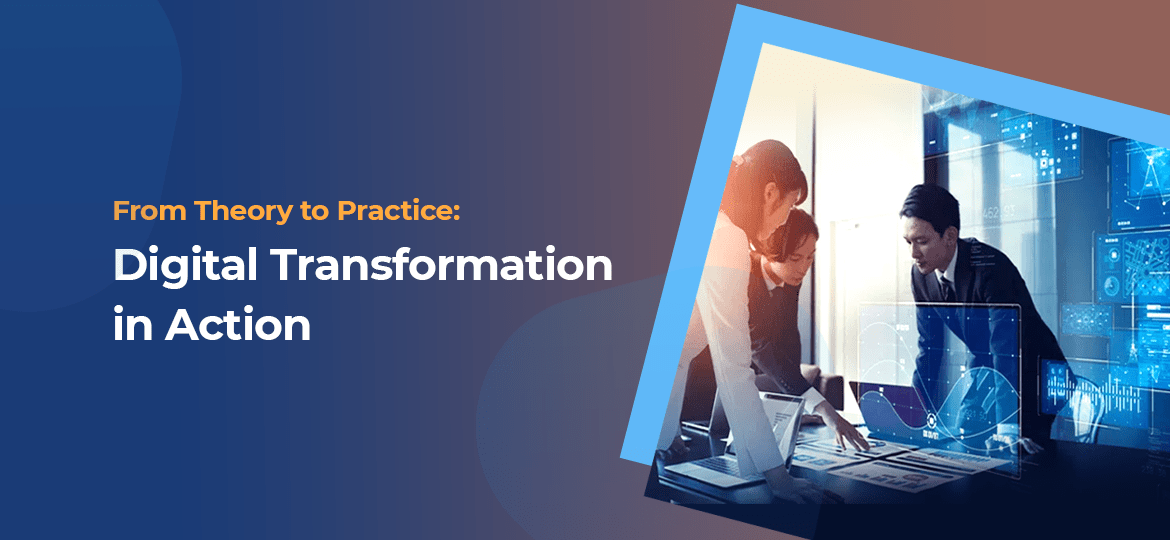
From Theory to Practice: Digital Transformation in Action
Digital transformation can seem overwhelming, especially when theory doesn’t match practical needs. The ABOAT framework—Analyze, Build, Optimize, Automate, Transform—helps bridge this divide, guiding you through each phase with actionable tools and insights to make your strategic vision both effective and impactful.
Intro
Digital transformation is often discussed in theory, but many organizations struggle to turn these ideas into actionable strategies that deliver real results. The challenge lies not only in identifying the right trends but also in effectively implementing them to drive meaningful change.
Without a clear roadmap, businesses risk falling behind, missing out on opportunities for growth, and failing to meet evolving customer expectations.
That’s where our approach comes in. In this article, “From Theory to Practice: Digital Transformation in Action,” we provide a practical toolkit designed to help you bridge this gap.
DIGITAL TRANSFORMATION IN ACTION
To solve this, organizations need a structured approach that bridges the gap between theory and practice.
That’s where the ABOAT framework comes in. This comprehensive toolkit guides you through each stage of your digital transformation journey, ensuring that your strategies are not only well-conceived but also effectively executed to achieve tangible results and stay ahead in the rapidly changing digital landscape.
Anchors aweigh! Here’s the ABOAT framework to power your transformation strategy.
1. ANALYZE
To Dos:
- Conduct a comprehensive audit: Evaluate all existing systems, processes, and technologies currently in use. This includes assessing their effectiveness, efficiency, and alignment with organizational goals.
- Gather data: Collect performance metrics, user feedback, and industry trends to gain a holistic view of how current systems are functioning and where gaps exist.
- Identify challenges and opportunities: Pinpoint inefficiencies, bottlenecks, and areas ripe for improvement or innovation. Identify key opportunities where digital transformation can make a significant impact.
Impact:
- Helps to make more informed, strategic decisions about where and how to implement digital transformation initiatives.
- Focuses improvements that directly address your organization’s pain points, leading to more effective and impactful digital transformation.
- Provides a strong foundation for strategic planning, ensuring that all subsequent DT efforts are aligned with organizational goals and have a measurable baseline for tracking progress.
2. BUILD
To Dos:
- Design digital solutions: Tailor digital tools, platforms, and technologies to meet the specific needs identified in the analysis phase. Focus on creating solutions that integrate seamlessly with existing systems.
- Develop and integrate: Build or customize the technology, ensuring it fits within the current ecosystem. This might include software development, platform integration, or upgrading existing infrastructure.
- Resource allocation:Allocate necessary resources – time, budget, personnel, and establish timelines for deployment.
Impact:
- Establishes a strong technological base that supports ongoing digital transformation efforts, ensuring that your organization is equipped to meet its strategic objectives.
- Provides the tools and infrastructure necessary to enhance operational efficiency, reduce redundancies, and improve overall productivity.
- Ensures that all technology solutions are aligned with long-term business goals and user needs, leading to more effective and sustainable digital transformation outcomes.
3. OPTIMIZE
To Dos:
- Monitor performance: Continuously track performance metrics and gather user feedback to assess how well the digital solutions are functioning.
- Implement improvements: Use data insights and testing to make iterative enhancements, fine-tuning the solutions for better performance, usability, and efficiency.
- Address issues: Proactively identify and resolve any emerging issues to maintain system stability and reliability.
Impact:
- By continuously refining digital solutions, your organization can achieve peak performance, ensuring that all systems operate at their highest possible efficiency.
- Regular optimization leads to a more intuitive, responsive, and satisfying user experience, which can increase engagement and satisfaction.
- Iterative improvements based on real-world data and user feedback lead to a higher return on investment, as the solutions deliver greater value and impact over time.
4. AUTOMATE
To Dos:
- Identify automation opportunities: Find repetitive, manual tasks that can be automated to save time and reduce human error.
- Develop automation workflows: Create and deploy automated processes, using tools and technologies that fit the identified needs and integrate with existing systems.
- Train and monitor: Provide training for staff on new automated processes, and continuously monitor the effectiveness and efficiency of these workflows.
Impact:
- Automation significantly lowers operational costs and reduces the likelihood of human error by handling repetitive tasks more efficiently.
- Automating time-consuming tasks frees up valuable resources, allowing staff to focus on more strategic, high-impact activities that drive business growth.
- Faster response times and more efficient processes enable your organization to adapt quickly to changes, maintaining a competitive edge in a dynamic market.
5. TRANSFORM
To Dos:
- Implement change management: Ensure that the transition to new digital solutions is smooth by using effective change management strategies. This includes communication, training, and support for all employees.
- Align culture and processes: Integrate digital capabilities into the organization’s culture and daily operations, ensuring that the transformation is holistic and sustainable.
- Measure and evaluate: Continuously assess the impact of digital transformation efforts on business outcomes, using metrics to guide ongoing improvements.
Impact:
- Enables your organization to meet and exceed its strategic objectives, driving innovation and long-term suc
- By embedding digital capabilities into your culture and processes, your organization becomes more agile, better able to respond to market shifts, and more competitive overall.
- Leads to sustained business growth, improving overall performance and positioning your organization as a leader in its industry.
WRAPPING UP
The road ahead is challenging, but with the right tools and insights, your vision can become a reality.
Our platform is a comprehensive strategy execution system that connects every facet of your business ecosystem. By seamlessly linking your business inputs – such as metrics, initiatives, and investments – with your desired outcomes, like forecasted revenue and margins, we provide a holistic view that empowers you to make informed, data-driven decision and ensure you that every action taken is aligned with your strategic vision, driving tangible results.

